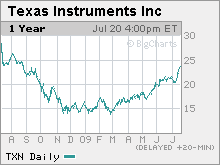Texas Instruments profit, outlook beat street
Falls short of predicting demand for its chips will rebound, remains cautious on economy.
NEW YORK (Reuters) -- Texas Instruments Inc. posted a stronger-than-expected quarterly profit and outlook, but was wary about declaring that the worst was over for the economy and demand for its chips.
TI (TXN, Fortune 500), whose chips are used in cell phones, televisions and industrial equipment, gave a wide forecast for revenue in the current quarter, indicating that visibility was still poor, and said high unemployment would likely hurt holiday season sales.
"End demand is still low in relation to where it was six to 12 months ago. We need to be prepared for slow to no growth for a while," TI Chief Financial Officer Kevin March told Reuters in an interview.
"We're getting close to finding the bottom of the economy although I don't think we've found it yet."
March said he saw growth in Asian markets, but the United Europe remained "soft to down." He was referring to analog chip sales and some strength in demand for notebook personal computers, hard-disk drives, smartphones, LCD TVs and video games.
Shares of TI, which had risen 13% in the week since Intel Corp.'s (INTC, Fortune 500) results beat Wall Street expectations, fell 1% in extended trading on Monday.
Analysts said that while TI had topped estimates, investors' expectations were already high after Intel and they were staying on the sidelines until they had more concrete signs that end customer demand was improving.
"The numbers were good. They were solid. The only possible negative could be that the wide revenue range signals that visibility is not improving," said Broadpoint Amtech analyst Doug Freedman.
TI, which competes with Qualcomm Inc. (QCOM, Fortune 500) in the wireless chip market, forecast third-quarter earnings per share of 29 cents to 39 cents, including 1 cent in restructuring charges, on revenue of $2.5 billion to $2.8 billion.
That was better than analysts' average forecast for earnings, excluding restructuring charges, of 28 cents on revenue of $2.53 billion, according to Reuters Estimates.
Company executives said the supply chain was moving much closer to being in balance with demand. They said inventory levels were declining at a slower rate, but did not believe there was any inventory build-up.
TI posted a second-quarter net profit of $260 million, or 20 cents per share, compared with $588 million, or 44 cents a share, in the same quarter a year ago.
Profit excluding restructuring costs was 25 cents per share, beating analysts' average forecast of 23 cents, according to Reuters Estimates.
Revenue fell 27% to $2.46 billion, close to the average Wall Street forecast of $2.42 billion.
Ashok Kumar, analyst at Collins Stewart LLC, said it could be September before there were clear signs of how much, if at all, end demand was improving.
"Q3 to Q4 (chip) demand will be more in line with end (product demand) as opposed to continued benefits of restocking," he said. "Now is where the rubber meets the road in terms of end demand."
TI shares fell to $23.35 following the results, after closing up 2.6% at $23.61 on the New York Stock Exchange. ![]()


